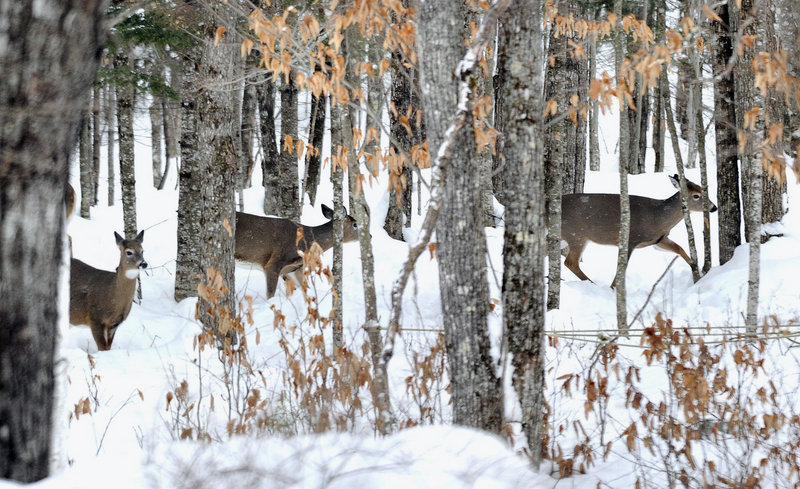For a white-footed mouse, two feet of snow might be welcome, but for a black-capped chickadee or a white-tailed deer, it’s bad, bad news.
For birds and animals, the bitter cold, deep snow and, now, rain and warmth are extremes in the battle for survival, from which some emerge in spring as winners. But others lose.
It’s nature’s way of keeping things in balance and ensuring that the strong survive, wildlife biologists and rehabilitators say.
“The strategies are really diverse,” Mike Windsor, of Maine Audubon Society in Falmouth, said of the various approaches to survival.
The first and most obvious is the one humans often embrace. “A lot of animals are really just hunkering down,” waiting for the worst to blow over, said Windsor. But in this recent round of extreme weather, “a lot of factors (were) coming together,” he said, meaning animals had to use “multiple strategies” to get through.
The birds seemed to sense the storm even before it started. Windsor noticed an uptick in activity the night before at the feeders in his own backyard. Eating more seed than usual packs on a little extra weight — not a bad plan just before a heavy snow. Then, when the bluster starts, they can sit tight and wait things out.
For some creatures, the snow is just the kind of insulating blanket they need to flourish, said Judy Camuso, wildlife biologist with the state Department of Inland Fisheries and Wildlife. Birds like ruffed grouse burrow in the snow for insulation, she said.
Some animals – mice, voles, moles and shrews, for example – also do better with snow cover, she said. It gives them a safer way to move around – in tunnels – that insulate them from turbulence and trouble above.
Having that protection makes it harder for owls to prey on tunneling mammals – but only in the short term. Avoiding raptors now may produce a really good rodent population come spring” – a boon to the owls, fox and fishers who feast on the small rodents and other mammals, she said.
As hard as current conditions might seem, native birds and animals “are pretty well adapted for this,” said Kristen Lamb, director for education and outreach at The Wildlife Center in Cape Neddick, which helps rescue and rehabilitate injured and orphaned animals.
But the harsh weather is not for the inexperienced.
Juvenile owls and hawks are among the most vulnerable creatures, Lamb said. In January alone, the center got 12 raptors, all hit by cars, she said.
Encounters with humans can be more risky than brutal weather. The snow and cold are challenge enough, Lamb said, but “when you add fish hooks, cats and cars on top of that,” it’s harder for already stressed birds and animals to survive.
Not all of the human impact is negative.
Some man-made “corridors,” like plowed driveways or snow tamped down by skis, snowmobiles and snowshoes, make movement a lot easier for deer and other large mammals, said Lamb’s colleague Sonja Ahlberg, a wildlife specialist at the center.
For birds, feeders are “an added boost,” though species that thrive on insects are out of luck right now, she said. Birds like juncos and goldfinches are greatly helped by people who heap on the seed, because “songbirds have to eat all the time” to make it through the cold months.
Goldfinches clung to the feeder at Ahlberg’s house in Cape Neddick right through the worst of the blizzard last Friday and Saturday, she said. “They didn’t move the entire time.”
Many species of birds including the black-capped chickadee use daily “torpor” to get through especially longer-term stretches of freezing weather, Lamb said. Daily torpor is like low-grade short-term hibernation: The metabolism slows for a few hours, using less energy and lowering body temperature just a few degrees and saving “a significant number of calories from being burned off overnight.”
Certain birds — including robins and eastern bluebirds — face additional hardships, if they stay this far north, at the margin of their range, Lamb said. The somewhat balmy winter of December and early January lulled some into lingering too long. Now they’re trying to make it in conditions wetter and colder than they’d prefer.
Ordinarily, the birds’ plumage provides adequate protection from the elements, Ahlberg said, but the snow-turned-to-rain, combined with the “wind ruffling their feathers . . . makes them more prone to hypothermia.”
Still, “winter dieoff” – the loss of a certain percentage of a species – is normal, Lamb said, and it actually prevents starvation and disease, because weaker individuals perish and the stronger flourish, in part because there is less competition for food.
Staff Writer North Cairn can be contacted at 791-6325 or at:
ncairn@mainetoday.com
Send questions/comments to the editors.


